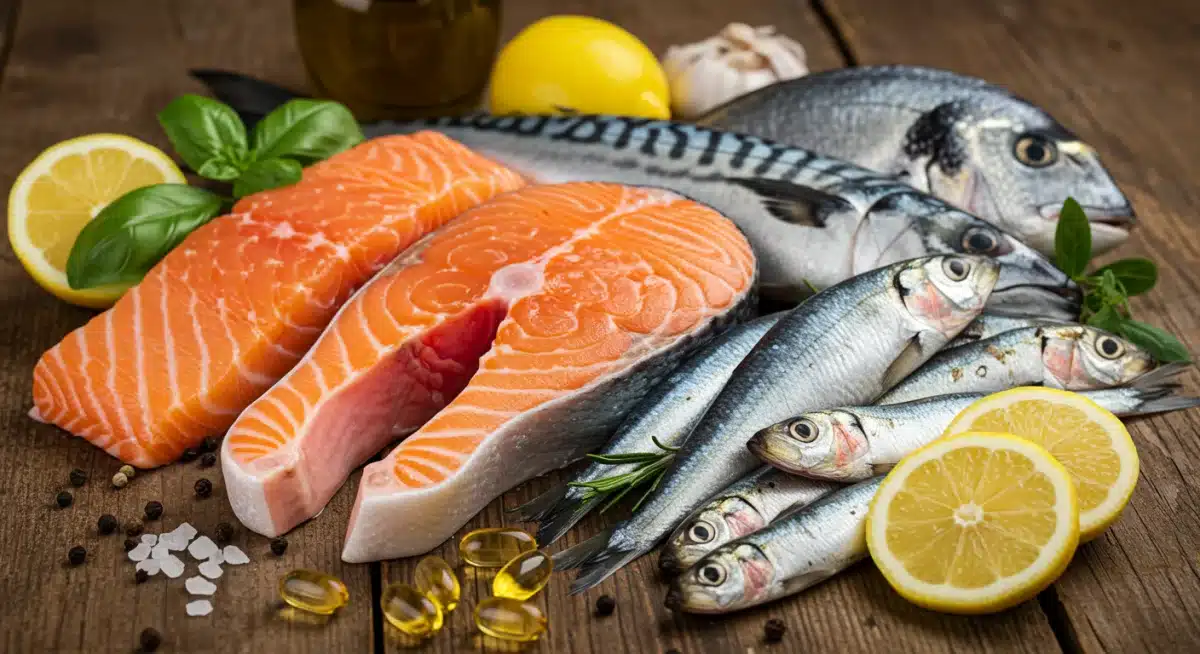Omega-3 for Kids: Optimal Fish Oil for Brain Development

Advertisement
For optimal brain development, children require specific amounts of omega-3 fatty acids, particularly DHA and EPA, found in fish oil, which are crucial for cognitive function, learning, and overall neurological health.
As parents, we constantly seek ways to support our children’s growth and well-being. Among the myriad of nutritional considerations, the role of omega-3 fatty acids, especially as found in fish oil, for optimal brain development often comes to the forefront. Understanding how much fish oil your child needs is not just about popping a pill; it’s about nurturing their cognitive potential from the ground up, ensuring they have the best possible foundation for learning and thriving. Let’s dive into the science and practicalities of harnessing omega-3 brain development power for your little ones.
Advertisement
The Crucial Role of Omega-3s in Early Childhood
Omega-3 fatty acids are a group of polyunsaturated fats essential for human health, particularly for growing children. These fats are considered ‘essential’ because the body cannot produce them on its own and must obtain them through diet. For children, omega-3s are not just beneficial; they are fundamental building blocks for crucial physiological processes.
During the rapid developmental stages of early childhood, the brain undergoes significant structural and functional changes. Omega-3s, especially docosahexaenoic acid (DHA), play a pivotal role in this intricate process. DHA is a primary structural component of the brain’s cerebral cortex and retina, making up about 20% of the fatty acids in the brain and 50% in the retina. Its presence is vital for nerve cell membranes, facilitating efficient communication between brain cells and supporting visual acuity.
Understanding DHA and EPA: The Dynamic Duo
When we talk about omega-3s in fish oil, two main types often come up: DHA and eicosapentaenoic acid (EPA). While both are important, their roles in children’s development have distinct emphases.
Advertisement
- DHA (Docosahexaenoic Acid): This is the superstar for brain and eye development. It’s concentrated in brain tissue and is critical for cognitive function, memory, and learning. Adequate DHA intake during early life is associated with better academic performance and reduced risks of certain neurodevelopmental disorders.
- EPA (Eicosapentaenoic Acid): While EPA also contributes to brain health, its primary benefits are often linked to its anti-inflammatory properties and its role in mood regulation and behavior. Some research suggests EPA can be particularly helpful in managing symptoms of ADHD and improving overall emotional well-being in children.
The synergy between DHA and EPA is what makes fish oil such a potent supplement. They work together to support overall brain function, nervous system health, and immune response. Ensuring a balanced intake of both is key to unlocking the full spectrum of benefits for your child’s developing mind and body.
In essence, omega-3s are indispensable for healthy brain development, impacting everything from cognitive function to emotional regulation. Their role in building and maintaining neural pathways underscores why parents should pay close attention to their child’s intake of these vital nutrients.
Recommended Daily Intake for Children: What the Experts Say
Determining the precise amount of omega-3s, particularly DHA and EPA, that a child needs can feel like navigating a complex maze. Guidelines vary slightly between different health organizations and age groups, but a general consensus exists regarding the importance of these fatty acids. It’s not a one-size-fits-all answer, as factors like age, diet, and individual health conditions can influence requirements.
For infants, breast milk is the ideal source of DHA, especially if the mother consumes sufficient omega-3s. Formula-fed infants should receive formulas fortified with DHA. As children grow, the focus shifts to dietary sources and, if necessary, supplementation.
Age-Specific Guidelines for Omega-3s
Here’s a general overview of recommended daily DHA + EPA intake for different age groups, based on various expert recommendations:
- Ages 1-3 years: Around 100-200 mg of combined DHA and EPA per day. This crucial period involves rapid brain growth and neural pathway formation.
- Ages 4-6 years: Approximately 150-250 mg of DHA and EPA daily. Children in this age range are developing more complex cognitive skills and engaging in early learning.
- Ages 7-12 years: Generally 250-500 mg of DHA and EPA per day. As children enter school, their cognitive demands increase, and omega-3s continue to support focus, memory, and information processing.
- Adolescents (13+ years): Similar to adult recommendations, typically 500-1000 mg of DHA and EPA daily, or even higher for specific health concerns.
It’s important to note that these are general guidelines. Some children, particularly those with certain developmental challenges or dietary restrictions, may benefit from higher doses, but this should always be discussed with a pediatrician or a registered dietitian. The key is to aim for a consistent intake rather than sporadic supplementation.
Natural Sources of Omega-3s: Beyond the Supplement Bottle
While fish oil supplements are a convenient way to ensure adequate omega-3 intake, the best approach always begins with a diet rich in these essential fats. Incorporating natural sources not only provides omega-3s but also a host of other beneficial nutrients that work synergistically to support overall health.
Fatty fish are the most potent natural sources of DHA and EPA. These include cold-water fish that accumulate omega-3s from their diet of algae and smaller fish. Aiming for two servings of fatty fish per week can significantly contribute to a child’s omega-3 needs.

Top Omega-3 Rich Foods for Kids
- Salmon: A fantastic source, versatile and often well-liked by children. Try baked salmon, salmon patties, or even flaked salmon in pasta dishes.
- Mackerel: Another excellent oily fish, though perhaps less common in children’s diets. It’s very high in omega-3s.
- Sardines: Small, but mighty! Canned sardines are convenient and can be added to salads, mashed on toast, or mixed into sauces.
- Tuna (light, canned): While fresh tuna has more, canned light tuna can be a good source, though limits should be placed due to potential mercury content. Albacore tuna has higher mercury levels and should be consumed less frequently.
- Herring: Similar to mackerel, herring is rich in omega-3s and can be found pickled or smoked.
For children who are picky eaters or have allergies, incorporating plant-based omega-3 sources (ALA – alpha-linolenic acid) is also important, although the conversion of ALA to DHA and EPA in the body is often inefficient. Good plant-based sources include flaxseeds, chia seeds, walnuts, and fortified foods like certain yogurts, milks, and eggs.
Encouraging a varied diet from an early age can help children develop a palate for these nutritious foods. Making mealtime fun and involving children in food preparation can also increase their willingness to try new things, including healthy fish dishes.
Choosing the Right Fish Oil Supplement for Your Child
Despite best efforts, some children may not consume enough omega-3s through diet alone. This is where supplements can play a valuable role. However, the market is flooded with various fish oil products, and choosing the right one requires careful consideration. Quality, purity, and appropriate dosing are paramount when selecting a supplement for your child.
Not all fish oil supplements are created equal. The source of the fish, the manufacturing process, and the form of omega-3s (e.g., triglycerides vs. ethyl esters) can all impact effectiveness and safety. It’s crucial to look for supplements specifically designed for children, as these often come in kid-friendly forms and dosages.
Key Factors When Selecting a Supplement
- Purity and Third-Party Testing: Fish oil can accumulate heavy metals like mercury and other environmental toxins. Look for brands that are third-party tested for purity and potency. Certifications from organizations like IFOS (International Fish Oil Standards) or GOED (Global Organization for EPA and DHA Omega-3s) are good indicators of quality.
- DHA and EPA Content: Pay close attention to the amount of DHA and EPA per serving, not just the total fish oil amount. Ensure it aligns with the recommended daily intake for your child’s age.
- Formulation and Flavor: Children are often particular about taste and texture. Many brands offer flavored liquid fish oils, chewable gummies, or small softgels that can be swallowed or chewed. Opt for formulations that your child will consistently take without a struggle.
- Triglyceride Form: Research suggests that omega-3s in the triglyceride form are better absorbed by the body compared to the ethyl ester form. Most high-quality children’s fish oils use the triglyceride form.
- Absence of Artificial Additives: Avoid supplements with artificial colors, flavors, sweeteners, or unnecessary fillers. Natural flavors derived from fruits are generally a better choice.
Always consult with your pediatrician before starting any new supplement, especially for children with existing health conditions or those on other medications. They can provide personalized advice based on your child’s specific needs and ensure there are no contraindications.
Potential Benefits Beyond Brain Development
While the focus on omega-3 brain development is well-deserved, the benefits of adequate omega-3 intake for children extend far beyond cognitive function. These essential fatty acids are involved in numerous physiological processes that contribute to a child’s overall health and well-being. Understanding these broader impacts can further emphasize the importance of ensuring sufficient omega-3s in their diet.
Omega-3s possess potent anti-inflammatory properties, which can be beneficial for various conditions. Chronic low-grade inflammation can impact different bodily systems, and omega-3s help to modulate this response, promoting healthier tissues and organ function.
Holistic Health Advantages for Growing Kids
- Vision Health: As a major component of the retina, DHA is critical for maintaining healthy vision and visual development, particularly in infants and young children.
- Immune System Support: Omega-3s can help regulate the immune system, potentially reducing the frequency and severity of infections. A well-functioning immune system is essential for children as they are frequently exposed to various pathogens.
- Cardiovascular Health: Although less commonly discussed for children, omega-3s contribute to the development of a healthy cardiovascular system by supporting healthy blood pressure and blood lipid profiles, laying the groundwork for long-term heart health.
- Bone Health: Emerging research suggests a link between omega-3 intake and improved bone mineral density, which is crucial during periods of rapid growth in childhood and adolescence.
- Skin Health: The anti-inflammatory properties of omega-3s can also benefit skin conditions, potentially helping to alleviate symptoms of eczema and other inflammatory skin issues.
These additional benefits underscore that omega-3s are not just a ‘brain food’ but a fundamental nutrient for comprehensive child development. By supporting these various systems, omega-3s contribute to a healthier, more resilient child, ready to explore and learn.
Addressing Common Concerns and Misconceptions
Parents often have questions and concerns regarding fish oil supplementation for children, ranging from safety to efficacy. It’s natural to seek clarity when making decisions about your child’s health. Addressing these common misconceptions can help parents make informed choices with confidence.
One primary concern revolves around the taste and smell of fish oil. Many parents worry their child will refuse to take it, or that it will cause ‘fishy burps.’ Fortunately, advancements in supplement technology have largely mitigated these issues, with many products now offering pleasant flavors and enteric coatings to prevent reflux.

Clarifying Doubts About Fish Oil for Kids
- Mercury Content: High-quality fish oil supplements are highly refined and purified, removing heavy metals like mercury and PCBs. Always choose reputable brands that provide third-party testing results to ensure purity.
- Dosage and Overdosing: While omega-3s are generally safe, excessive doses can lead to mild side effects like upset stomach or increased bleeding risk. Sticking to recommended dosages and consulting a healthcare professional is crucial.
- Allergies: Children with fish allergies should avoid fish oil supplements. Algae-based DHA supplements are a safe alternative for these children and vegetarians/vegans.
- Interaction with Medications: Fish oil can interact with certain medications, particularly blood thinners. Always inform your pediatrician about any supplements your child is taking.
- Efficacy: While some studies show significant benefits, others have more modest findings. The effectiveness can depend on the child’s baseline omega-3 levels, specific health conditions, and consistency of intake. It’s not a magic bullet, but a supportive nutrient.
Understanding these points helps demystify fish oil supplementation. When chosen carefully and used appropriately, fish oil can be a safe and beneficial addition to a child’s nutritional regimen, complementing a healthy diet rather than replacing it. Always prioritize open communication with your healthcare provider for personalized guidance.
Integrating Omega-3s into Your Child’s Daily Routine
Successfully incorporating omega-3s into a child’s diet, whether through food or supplements, often requires a strategic and consistent approach. Children thrive on routine, and making healthy habits a regular part of their day can lead to better long-term adherence and benefits.
The goal is to make omega-3 intake a seamless and enjoyable part of their lifestyle, rather than a chore. This involves creativity in meal planning and choosing supplements that are palatable and easy to administer.
Practical Strategies for Parents
- Creative Cooking: Experiment with different ways to prepare fish. Instead of plain baked fish, try fish tacos, fish sticks (homemade for healthier options), or incorporate flaked fish into pasta sauces or casseroles.
- Smoothie Boosts: For plant-based omega-3s, blend flaxseeds or chia seeds into smoothies. Their mild flavor and smooth texture make them easily hidden. Some liquid fish oils are also designed to be mixed into drinks without altering taste significantly.
- Fortified Foods: Look for foods fortified with omega-3s, such as certain brands of milk, yogurt, eggs, and bread. While these may not provide the same high levels as fatty fish or supplements, they can contribute to overall intake.
- Consistent Supplementation: If using a supplement, establish a routine. Administer it at the same time each day, perhaps with breakfast or dinner, to help your child remember and accept it as part of their daily regimen.
- Lead by Example: Children often mimic their parents. If you regularly consume omega-3 rich foods or take supplements, your child is more likely to view it as a normal and healthy practice. Make healthy eating a family affair.
Patience and persistence are key. It may take several attempts for a child to accept new foods or supplements. Celebrate small victories and maintain a positive attitude around healthy eating. By making omega-3 intake a positive experience, you’re not just supporting their current development but also fostering lifelong healthy habits.
| Key Point | Brief Description |
|---|---|
| DHA’s Brain Role | DHA is a critical structural component of the brain and retina, vital for cognitive function, memory, and visual acuity in children. |
| Recommended Intake | Daily DHA/EPA needs vary by age, generally increasing from 100-200mg for toddlers to 250-500mg for school-aged children. |
| Food Sources | Fatty fish like salmon, mackerel, and sardines are prime sources. Plant-based ALA sources also contribute. |
| Supplement Selection | Choose third-party tested, triglyceride-form supplements with appropriate DHA/EPA levels and kid-friendly flavors. |
Frequently Asked Questions About Omega-3s for Children
Fish oil supplements are generally safe for children starting from around 6 months of age, often in liquid form. However, it’s crucial to consult with your pediatrician before introducing any supplement to infants or young children to ensure appropriate dosage and suitability for their specific health needs.
Side effects are usually mild and uncommon when taken at recommended doses. They can include a fishy aftertaste, bad breath, upset stomach, or loose stools. To minimize these, give fish oil with meals and choose high-quality, enteric-coated supplements. Consult a doctor if concerns persist.
While plant-based sources like flaxseeds and walnuts provide ALA, the conversion to DHA and EPA in the body is often inefficient, especially for children. For optimal brain development, direct sources of DHA and EPA from fatty fish or algae-based supplements are generally recommended to ensure adequate intake.
It can be difficult to tell without testing. Signs of deficiency are non-specific and could include dry skin, poor concentration, or mood swings. The best way is to review their diet for fatty fish intake and discuss with your pediatrician if supplementation might be beneficial based on their dietary habits.
Fish oil is derived from the flesh of various fatty fish and primarily contains EPA and DHA. Cod liver oil comes specifically from cod livers and contains EPA, DHA, and also significant amounts of Vitamins A and D. While beneficial, care must be taken with cod liver oil to avoid excessive vitamin A intake.
Conclusion
The journey to supporting a child’s optimal brain development is multifaceted, and omega-3 fatty acids, particularly DHA and EPA from fish oil, stand out as undeniably crucial nutrients. From the foundational building blocks of brain cells to enhancing cognitive function, mood regulation, and even broader health benefits like vision and immunity, the power of omega-3s is profound. By understanding recommended daily intakes, exploring diverse food sources, and making informed choices about high-quality supplements when necessary, parents can confidently ensure their children receive the essential support needed for thriving minds and bodies. Ultimately, fostering a balanced diet rich in these vital fats is an investment in their lifelong potential.





